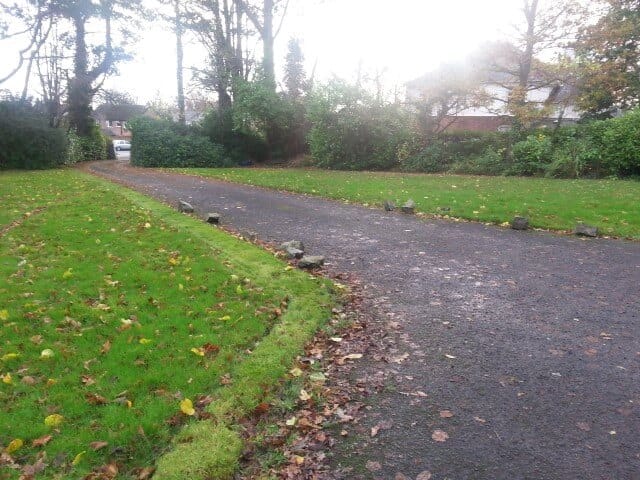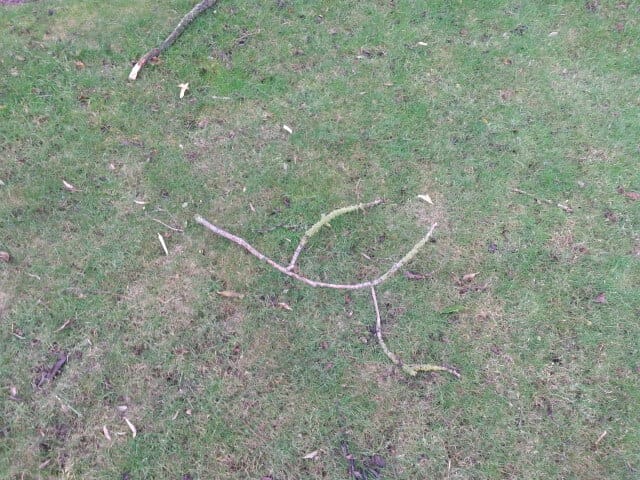In this article we look at winter lawn mowing and ask “Can I cut my lawn in winter?”

I’m writing this in early December when wintery weather and dark evenings tend to keep folks indoors a lot more. Grass will continue to grow all year round if weather conditions are right, at the moment the ground is still warm above 5°C and the lawns are continuing to grow. At this time of year lawns tend to take second place to Christmas preparations. The lack of attention sometimes leaves lawns looking less neat than usual and clients often ask me “can I cut my lawn in winter? Here’s my advice
Rules for winter lawn mowing
Absolutely, yes! You can cut your lawn in winter. But there are a few common sense rules to stick to.
1: Avoid mowing your lawn when the ground is wet
Soggy soil is very vulnerable to compaction – especially if it’s typical of the clay soils found around Belfast. Healthy soil consists of millions of tiny particles of rock, minerals and organic matter. It’s home to lots of tiny organisms who help plants to thrive. Between the particles are spaces filled with air. Those spaces are crucial for the health of your soil. They allow water, air and nutrients to all of the living things in the soil – including the roots of your lawn grasses.
When you walk on wet soil, you squeeze the particles closer together and make it more difficult for essential elements to circulate.
Clay soil has smaller, stickier particles than sandy or chalky soil. When they are squished together, they stick to each other. That means that the air spaces disappear and don’t bounce back until your friendly lawn care man aerates your lawn in spring. Consequently, your lawn grasses will be getting less of the things it needs.
If your lawn needs mowing in winter, wait until we’ve had at least a couple of days without rain.
Grass will continue to grow all year round if weather conditions are right, at the moment as we have had very little frost and the ground is still warm above 5°C and the lawns are continuing to grow.
2: Remove every last piece of debris

While you are walking over the lawn to pick up leaves, twigs, dog poo and anything else that might be sitting on your lawn, you’ll be able to assess if the soil is dry enough for mowing. (see point 1). If you can feel your feet sinking slightly every time you take a step – leave the mower in the shed for another day.
Lawn debris needs to be removed even if it is too wet to mow. Worm casts can be left to dry and then brushed off with a stiff broom
3: Frosty weather
Frost puts a sparkle on the lawn and shows up every single piece of stray grass. BUT walking on your lawn when it is frozen will do untold damage.

Frozen grass doesn’t spring back when walked on and footprints can remain for a very long time
Each blade of grass is make up of trillions of individual cells. Each cell contains tiny vital organs that are floated in water for protection. Now, left to its own devices, grass is remarkably frost tolerant. The water in the cells freezes and then it thaws. The plant is not affected.
Now picture each cell as a water balloon. It’s normally quite flexible but when it’s subjected to gentle pressure it will change shape. If the water inside it is frozen, the smallest tap on the cell surface will send violent shock waves through the ice. Those shock waves will potentially damage the vital organs that are dormant inside the ice. If that happens, the cell will die. When lots of cells are affected the whole leaf will die and turn brown.
Which is why, walking on the grass when it is frozen will leave visible brown footprints on the lawn when it thaws.
4: Be careful not to scalp your lawn
If you need to cut your lawn in winter, please raise the cutting blade a little higher than usual. NEVER remove more than one third of the grass blades in one go. Remember that the leaves on a grass plant are there to harvest energy from the sun and keep the plant alive. Winter days are short and the sun’s rays are weak. The larger the surface area of a plant’s leaves, the more sunshine it can harvest. So for winter lawns, longer is better. For a ryegrass mix lawn, I recommend a cutting height of no less than 4-5cm.
5: Remove all cuttings
Going back to point 4 – it’s important that your lawn is exposed to as much sunlight as possible. If you were to leave clippings on the surface they would block that light. Plus, wet clippings sitting on a winter lawn are the ideal breeding ground for diseases such as fusarium patch.
6: Replace lost nutrients with a winter lawn feed
More about seasonal lawn treatments in this blogpost.
To summarise: Can you cut your lawn in winter?
Yes you can mow your lawn in winter, just be sure to
- Avoid mowing when the soil is wet
- Keep off the lawn when it’s frozen
- Raise the mower blades and don’t scalp the grass
- Remove all clippings
- If at all unsure, ask a lawncare professional to help. They usually have mowers that can cope with longer or wet grass.
Contact Premier Lawns NI for help with winter lawn care
Book your spring lawn renovations
